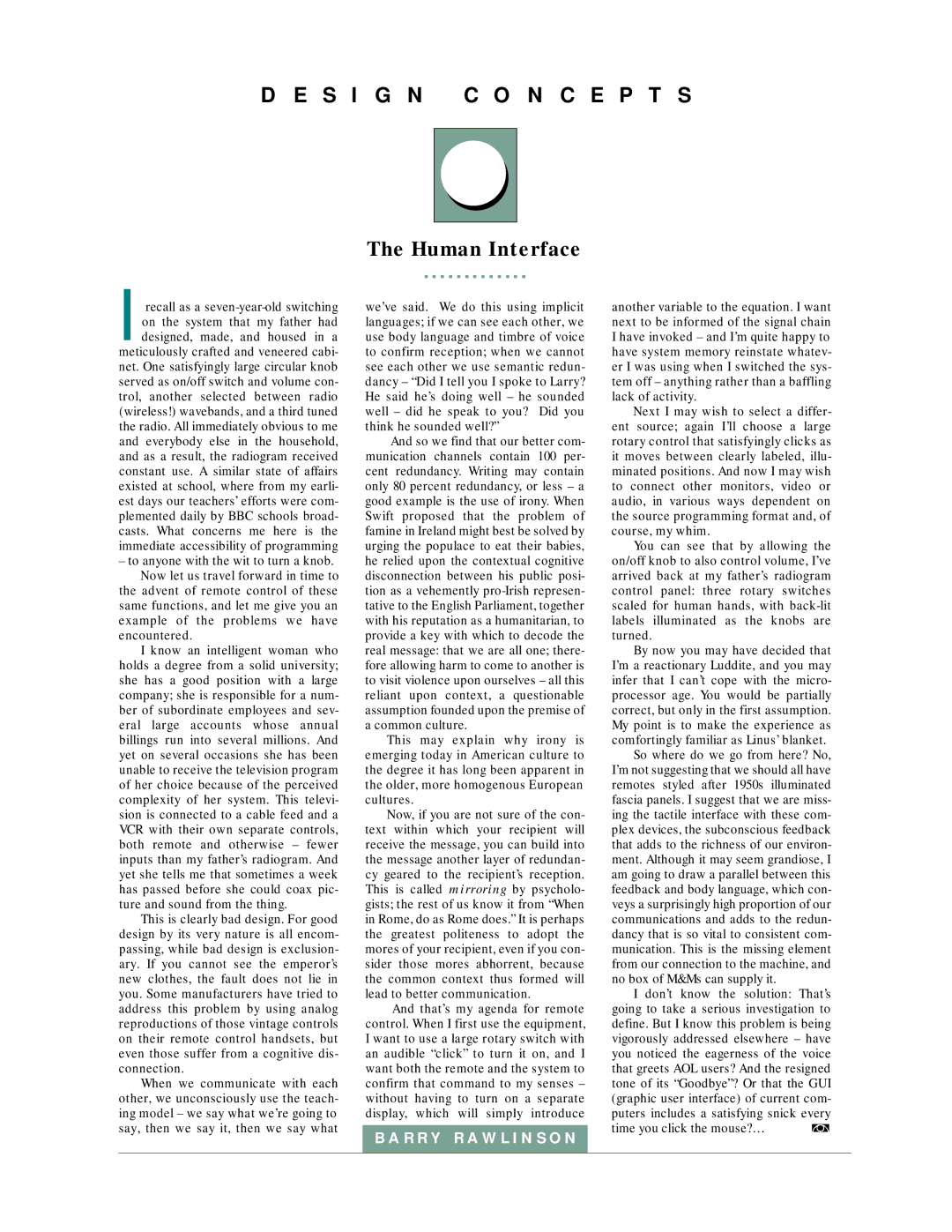
D E S I G N C O N C E P T S
The Human Interface
. . . . . . . . . . . . .
I recall as a
– to anyone with the wit to turn a knob. Now let us travel forward in time to the advent of remote control of these same functions, and let me give you an example of the problems we have
encountered.
I know an intelligent woman who holds a degree from a solid university; she has a good position with a large company; she is responsible for a num- ber of subordinate employees and sev- eral large accounts whose annual billings run into several millions. And yet on several occasions she has been unable to receive the television program of her choice because of the perceived complexity of her system. This televi- sion is connected to a cable feed and a VCR with their own separate controls, both remote and otherwise – fewer inputs than my father’s radiogram. And yet she tells me that sometimes a week has passed before she could coax pic- ture and sound from the thing.
This is clearly bad design. For good design by its very nature is all encom- passing, while bad design is exclusion- ary. If you cannot see the emperor’s new clothes, the fault does not lie in you. Some manufacturers have tried to address this problem by using analog reproductions of those vintage controls on their remote control handsets, but even those suffer from a cognitive dis- connection.
When we communicate with each other, we unconsciously use the teach- ing model – we say what we’re going to say, then we say it, then we say what
we’ve said. We do this using implicit languages; if we can see each other, we use body language and timbre of voice to confirm reception; when we cannot see each other we use semantic redun- dancy – “Did I tell you I spoke to Larry? He said he’s doing well – he sounded well – did he speak to you? Did you think he sounded well?”
And so we find that our better com- munication channels contain 100 per- cent redundancy. Writing may contain only 80 percent redundancy, or less – a good example is the use of irony. When Swift proposed that the problem of famine in Ireland might best be solved by urging the populace to eat their babies, he relied upon the contextual cognitive disconnection between his public posi- tion as a vehemently
This may explain why irony is emerging today in American culture to the degree it has long been apparent in the older, more homogenous European cultures.
Now, if you are not sure of the con- text within which your recipient will receive the message, you can build into the message another layer of redundan- cy geared to the recipient’s reception. This is called mirroring by psycholo- gists; the rest of us know it from “When in Rome, do as Rome does.” It is perhaps the greatest politeness to adopt the mores of your recipient, even if you con- sider those mores abhorrent, because the common context thus formed will lead to better communication.
And that’s my agenda for remote control. When I first use the equipment, I want to use a large rotary switch with an audible “click” to turn it on, and I want both the remote and the system to confirm that command to my senses – without having to turn on a separate display, which will simply introduce
another variable to the equation. I want next to be informed of the signal chain I have invoked – and I’m quite happy to have system memory reinstate whatev- er I was using when I switched the sys- tem off – anything rather than a baffling lack of activity.
Next I may wish to select a differ- ent source; again I’ll choose a large rotary control that satisfyingly clicks as it moves between clearly labeled, illu- minated positions. And now I may wish to connect other monitors, video or audio, in various ways dependent on the source programming format and, of course, my whim.
You can see that by allowing the on/off knob to also control volume, I’ve arrived back at my father’s radiogram control panel: three rotary switches scaled for human hands, with
By now you may have decided that I’m a reactionary Luddite, and you may infer that I can’t cope with the micro- processor age. You would be partially correct, but only in the first assumption. My point is to make the experience as comfortingly familiar as Linus’ blanket.
So where do we go from here? No, I’m not suggesting that we should all have remotes styled after 1950s illuminated fascia panels. I suggest that we are miss- ing the tactile interface with these com- plex devices, the subconscious feedback that adds to the richness of our environ- ment. Although it may seem grandiose, I am going to draw a parallel between this feedback and body language, which con- veys a surprisingly high proportion of our communications and adds to the redun- dancy that is so vital to consistent com- munication. This is the missing element from our connection to the machine, and no box of M&Ms can supply it.
I don’t know the solution: That’s going to take a serious investigation to define. But I know this problem is being vigorously addressed elsewhere – have you noticed the eagerness of the voice that greets AOL users? And the resigned tone of its “Goodbye”? Or that the GUI (graphic user interface) of current com- puters includes a satisfying snick every time you click the mouse?… ![]()
